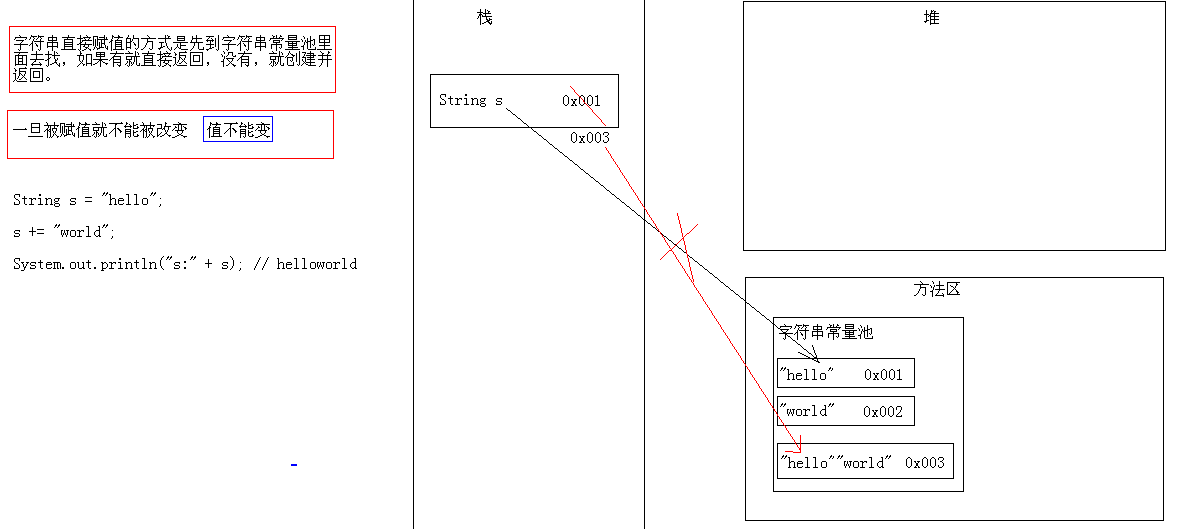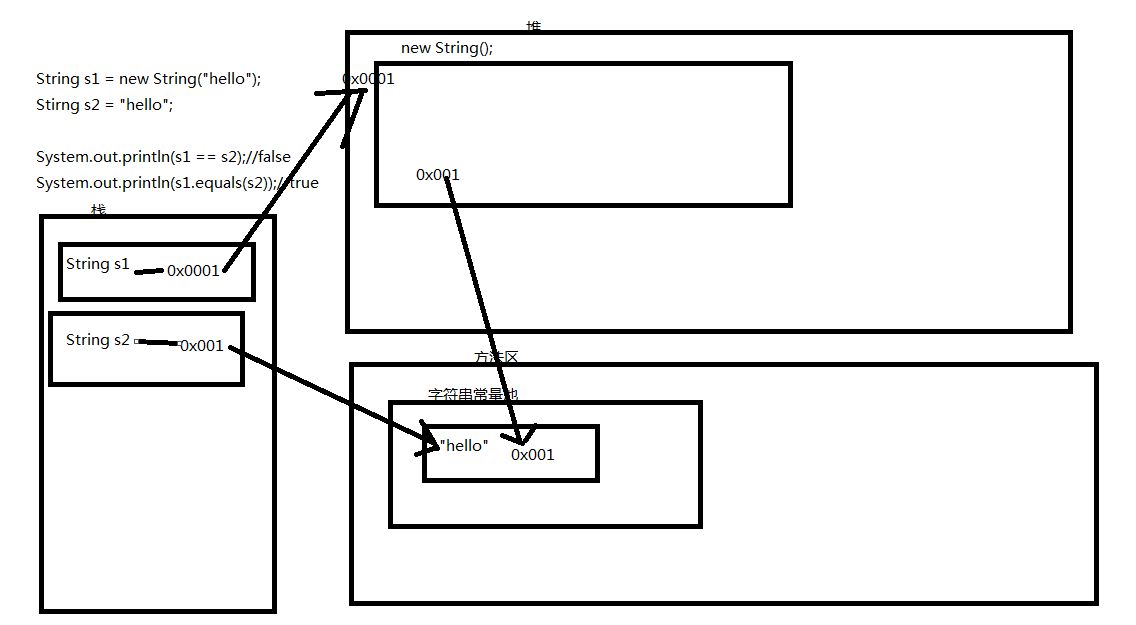1. Overview of strings
String: It is a string of characters composed of multiple characters, which can also be regarded as a character array.
The String class represents a string, and string literals in Java programs, such as "abc", are implemented as instances of this class.
Strings are constants. Once assigned, they cannot be changed.
2. String construction method
public String() empty construction
public String(byte[] bytes) Convert byte array into string
public String(byte[] bytes, int offset, int length) Convert the bytes of the specified index length of the byte array into a string
public String(char[] value) Convert the character array into a string
public String(char[] values, int offset, int count ) Convert the characters of the specified index length of the character array into a string
public String(String original) Convert the string constant value into a string
package cn;
/**
* 字符串:就是由多個(gè)字符組成的一串字符,也可以看成是字符數(shù)組
* 通過(guò)查看API,我們可以知道
* 字符串字面值"abc"也可以看成是一個(gè)字符串對(duì)象。
* 字符串是常量,一旦被賦值,就不能被改變。
*
* 構(gòu)造方法:
* public String() 空構(gòu)造
* public String(byte[] bytes) 把字節(jié)數(shù)組轉(zhuǎn)換成字符串
* public String(byte[] bytes,int offset,int length)
把字節(jié)數(shù)組的指定索引長(zhǎng)度的字節(jié)轉(zhuǎn)換成字符串
* public String(char[] value) 把字符數(shù)組轉(zhuǎn)換成字符串
* public String(char[] values,int offset,int count)
把字符數(shù)組的指定索引長(zhǎng)度的字符轉(zhuǎn)換成字符串
* public String(String original) 把字符串常量值轉(zhuǎn)換成字符串
*
* 字符串的方法:
* public int length()獲取字符串的長(zhǎng)度
*/
public class StringDemo {
public static void main(String[] args) {
//public String() 空構(gòu)造
String s1 = new String();
System.out.println("s1:"+s1);//s1:
//public String(byte[] bytes) 把字節(jié)數(shù)組轉(zhuǎn)換成字符串
byte[] bytes1 = new byte[]{97,98,99};
String s2 = new String(bytes1);
System.out.println("s2:"+s2);//s2:abc
//public String(byte[] bytes,int offset,int length)
// 把字節(jié)數(shù)組的指定索引長(zhǎng)度的字節(jié)轉(zhuǎn)換成字符串
byte[] bytes2 = new byte[]{97,98,99,100};
String s3 = new String(bytes2,1,2);
System.out.println("s3:"+s3);//s3:bc
//public String(char[] value) 把字符數(shù)組轉(zhuǎn)換成字符串
char[] char1 = new char[]{'a','b','c'};
String s4 = new String(char1);
System.out.println("s4:"+s4);//s4:abc
//public String(char[] values,int offset,int count)
// 把字符數(shù)組的指定索引長(zhǎng)度的字符轉(zhuǎn)換成字符串
char[] char2 = new char[]{'a','b','c','d','e'};
String s5 = new String(char2,1,2);
System.out.println("s5:"+s5);//s5:bc
//public String(String original) 把字符串常量值轉(zhuǎn)換成字符串
String s6 = new String("HelloWorld");
System.out.println("s6:"+s6);//s6:HelloWorld
}
}3. Characteristics of strings: Once declared, they cannot be changed
package com;
/**
* 字符串的特點(diǎn):一旦被賦值,就不能被改變。
* 指的是字符串"hello"不可以改變 嗎,而不是變量s
*
* 字符串直接賦值的方式是先到字符串常量池里面去找,
* 如果有就直接返回,沒(méi)有,就創(chuàng)建并返回。
*
*/
public class StringDemo {
public static void main(String[] args) {
String s = "hello";
s += "world";
System.out.println("s:"+s);//s:helloworld
}
}
4. The difference between String direct assignment and object creation
package com;
/**
* String s1 = "hello";和 String s2 = new String("hello")的區(qū)別
* 前者會(huì)創(chuàng)建2個(gè)對(duì)象,后者會(huì)創(chuàng)建一個(gè)對(duì)象。
*
* ==在基本類型中,比較的是值是否相等。在引用類型中,比較的是地址值是否相等。
* equals()在Object類中比較的是地址值是否相等。
* 但是String重寫了equals()方法,所以在String比較的是內(nèi)容是否相等。
*/
public class StringDemo2 {
public static void main(String[] args) {
String s1 = "hello";
String s2 = new String("hello");
System.out.println(s1 == s2);//false
System.out.println(s1.equals(s2));//true
}
}
5. Practice
package com;
/**
* 看程序?qū)懡Y(jié)果
*/
public class StringDemo3 {
public static void main(String[] args) {
String s1 = new String("hello");
String s2 = new String("hello");
System.out.println(s1 == s2);//false
System.out.println(s1.equals(s2));//true
String s3 = new String("hello");
String s4 = "hello";
System.out.println(s3 == s4);//false
System.out.println(s3.equals(s4));//true
String s5 = "hello";
String s6 = "hello";
System.out.println(s5 == s6 );//true
System.out.println(s5.equals(s6));//true
}
}package com;
/**
* 看程序,寫結(jié)果
* 字符串如果是變量相加,先開(kāi)辟空間,再拼接
* 字符串如果是常量相加,是先相加,然后再在常量池中尋找,如果有就直接返回,否則,就創(chuàng)建
*/
public class StringDemo4 {
public static void main(String[] args) {
String s1 = "hello";
String s2 = "world";
String s3 = "helloworld";
System.out.println(s1.hashCode()+s2.hashCode());
System.out.println(s3.hashCode());
/**
* s3 就相當(dāng)于是s3.hashCode()
* 而s1 + s2 就相當(dāng)于s1.hashCode() + s2.hashCode()
* 當(dāng)然不一樣了
*/
System.out.println(s3 == s1 + s2);//false
System.out.println(s3.equals(s1 + s2));//true
System.out.println(s3 == "hello"+"world");//true
System.out.println(s3.equals("hello"+"world"));//true
/**
* 通過(guò)反編譯,看源碼,我們知道這里已經(jīng)做好了處理
*/
System.out.println(s3=="helloworld");
System.out.println(s3.equals("helloworld"));
}
}6. The judgment function of String class
public boolean equals(Object obj) judges the difference between two strings Whether the contents are equal, case-sensitive
public boolean equalsIgnoreCase(String str) Determines whether two strings are equal, case-insensitive
public contains(String str) Determines whether a large string contains a small string
public boolean stratsWith(String str) Determines whether the string begins with a specified string
pubilc booelan endsWithd(String str) Determines whether the string ends with a specified string
public boolean isEmpty() Determines characters Whether the content of the string is empty
package cn;
/**
* String類的判斷功能
* public boolean equals(Object obj) 判斷字符串的內(nèi)容是否相等,區(qū)分大小寫
* public boolean equalsIgnoreCase(String str) 判斷字符串的內(nèi)容是否相等,不區(qū)分大小寫
* public contains(String str) 判斷大的字符串中是否包含小的字符串
* public boolean startsWith(String str) 判斷是否以某種字符串開(kāi)開(kāi)頭
* public boolean endsWith(String str) 判斷是否以某種字符串結(jié)尾
* public boolean isEmpty() 判斷字符串的內(nèi)容是否為空
*
*/
public class StringDemo2 {
public static void main(String[] args) {
//創(chuàng)建字符串對(duì)象
String s1 = "helloworld";
String s2 = "helloworld";
String s3 = "helloWorld";
//public boolean equals(Object obj) 判斷字符串的內(nèi)容是否相等,區(qū)分大小寫
System.out.println(s1.equals(s3));//false
System.out.println(s1.equals(s2));//true
//public boolean equalsIgnoreCase(String str) 判斷字符串的內(nèi)容是否相等,不區(qū)分大小寫
System.out.println(s1.equalsIgnoreCase(s3));//true
System.out.println(s1.equalsIgnoreCase(s2));//true
//public contains(String str) 判斷大的字符串中是否包含小的字符串
System.out.println(s1.contains("hello"));//true
System.out.println(s1.contains("hw"));//false
//public boolean startsWith(String str) 判斷是否以某種字符串開(kāi)開(kāi)頭
System.out.println(s1.startsWith("hello"));//true
System.out.println(s1.startsWith("h"));//true
System.out.println(s1.startsWith("world"));//false
//public boolean endsWith(String str) 判斷是否以某種字符串結(jié)尾
System.out.println(s1.endsWith("world"));//true
//public boolean isEmpty() 判斷字符串是否為空
System.out.println(s1.isEmpty());//false
String s4 = "";
System.out.println(s4.isEmpty());//true
String s5 = null;
/**
* Exception in thread "main" java.lang.NullPointerException
* 因?yàn)閟5的對(duì)象不存在,它怎么可以調(diào)用方法呢??
*/
//System.out.println(s5.isEmpty());
}
}7. Practice
package cn;
import java.util.Scanner;
/**
*
* 模擬登錄,給三次機(jī)會(huì),并提示還有幾次機(jī)會(huì)
*
* 分析:
* 1.定義用戶名和密碼,已經(jīng)存在的
* 2.鍵盤錄入用戶名和密碼。
* 3.比較用戶名和密碼,如果都相同,則登錄成功,如果有一個(gè)不同,則登錄失敗
* 4.給三次機(jī)會(huì),用循環(huán)改進(jìn),用for循環(huán)
*/
public class StringDemo1 {
public static void main(String[] args) {
//定義用戶名和密碼,已經(jīng)存在的
String username = "admin";
String password = "admin";
for (int i = 0; i < 3; i++) {
//鍵盤錄入用戶名和密碼
Scanner sc = new Scanner(System.in);
System.out.println("請(qǐng)輸入用戶名:");
String name = sc.next();
System.out.println("請(qǐng)輸入密碼:");
String pwd = sc.next();
//比較用戶名和密碼,如果都相同,則登錄成功,如果有一個(gè)不同,則登錄失敗
if(username.equals(name) && password.equals(pwd)){
//如果都相同,則登錄成功
System.out.println("登錄成功");
break;
}else{
//如果有一個(gè)不同,則登錄失敗
if((2-i) == 0){//如果是第0次,那么就
System.out.println("抱歉,帳號(hào)被鎖定。");
}else{
System.out.println("登錄失敗,你還有"+(2-i)+"次機(jī)會(huì)");
}
}
}
}
}Improvement
package cn;
import java.util.Scanner;
/**
*
* 模擬登錄,給三次機(jī)會(huì),并提示還有幾次機(jī)會(huì),如果登錄成功,就可以玩猜數(shù)字了
*
* 分析:
* 1.定義用戶名和密碼,已經(jīng)存在的
* 2.鍵盤錄入用戶名和密碼。
* 3.比較用戶名和密碼,如果都相同,則登錄成功,如果有一個(gè)不同,則登錄失敗
* 4.給三次機(jī)會(huì),用循環(huán)改進(jìn),用for循環(huán)
*/
public class StringDemo1 {
@SuppressWarnings("resource")
public static void main(String[] args) {
//定義用戶名和密碼,已經(jīng)存在的
String username = "admin";
String password = "admin";
boolean flag = false;
for (int i = 0; i < 3; i++) {
//鍵盤錄入用戶名和密碼
Scanner sc = new Scanner(System.in);
System.out.println("請(qǐng)輸入用戶名:");
String name = sc.next();
System.out.println("請(qǐng)輸入密碼:");
String pwd = sc.next();
//比較用戶名和密碼,如果都相同,則登錄成功,如果有一個(gè)不同,則登錄失敗
if(username.equals(name) && password.equals(pwd)){
flag = true;
//如果都相同,則登錄成功
System.out.println("登錄成功");
break;
}else{
//如果有一個(gè)不同,則登錄失敗
if((2-i) == 0){//如果是第0次,那么就
System.out.println("抱歉,帳號(hào)被鎖定。");
}else{
System.out.println("登錄失敗,你還有"+(2-i)+"次機(jī)會(huì)");
}
}
}
if(flag){
GuessNumberGame.start();
}
}
}
package cn;
import java.util.Scanner;
/**
* 創(chuàng)建猜數(shù)字的小游戲
*/
public class GuessNumberGame {
private GuessNumberGame(){}
@SuppressWarnings("resource")
public static void start(){
//產(chǎn)生一個(gè)隨機(jī)數(shù)
int number = (int)(Math.random() * 100 ) + 1 ;
System.out.println(number);
while(true){
Scanner sc = new Scanner(System.in);
System.out.println("請(qǐng)輸入你要猜的數(shù)據(jù)(1-100):");
int guessNumber = sc.nextInt();
//判斷
if(guessNumber > number){
System.out.println("你猜的數(shù)據(jù)"+guessNumber+"大了");
}else if (guessNumber < number){
System.out.println("你猜的數(shù)據(jù)"+guessNumber+"小了");
}else{
System.out.println("恭喜你,猜中了");
break;
}
}
}
}8. String class acquisition function
public int length() Get the length of the string
public char charAt(int index) Get the specified index The character at the position
Why is it of int type instead of char type?
Because: 'a' and 97 can be converted to each other, that is, 97 represents 'a'
public int indexOf(int ch) returns the position where the specified character first appears in this string
public int indexOf (String str) Returns the position where the specified string first appears in this string
public int indexOf(int ch,int fromIndex) Returns the position where the specified character first appears in this payment string from the specified position
public int indexOf(Sring str,itn fromIndex) Returns the position where the specified string appears for the first time in the specified position
public String subString(int start) The string intercepted from the specified position
public String subString (int strat, int end) A string intercepted from the beginning of the specified position to the end of the specified position
package cn;
/**
* String類的獲取功能
* public int length() 獲取字符串的長(zhǎng)度
* public char charAt(int index) 獲取指定索引位置上的字符
* 為什么這里是int類型,而不是char類型?
* 因?yàn)?'a'和97是可以相互轉(zhuǎn)換的,即97就是代表'a'
* public int indexOf(int ch) 返回指定字符在此字符串中第一次出現(xiàn)的位置
* public int indexOf(String str) 返回指定字符串在此字符串中第一次出現(xiàn)的位置
* public int indexOf(int ch,int fromIndex)返回指定字符在此支付串從指定位置中第一次出現(xiàn)的位置
* public int indexOf(Sring str,itn fromIndex) 返回指定字符串在此字符串從指定位置中第一次出現(xiàn)的位置
* public String subString(int start) 從指定位置開(kāi)始截取的字符串
* public String subString(int strat,int end) 從指定位置開(kāi)始到指定位置結(jié)束時(shí)截取的字符串
*/
public class StringDemo4 {
public static void main(String[] args) {
//定義一個(gè)字符串
String s = "helloworld";
//public int length() 獲取字符串的長(zhǎng)度
System.out.println("s的長(zhǎng)度是:"+s.length());//s的長(zhǎng)度是:10
//public char charAt(int index) 獲取指定索引位置上的字符
System.out.println(s.charAt(0));//h
//public int indexOf(int ch) 返回指定字符在此字符串中第一次出現(xiàn)的位置
System.out.println("l出現(xiàn)第一次的索引"+s.indexOf('l'));//l出現(xiàn)第一次的索引2
//public int indexOf(String str) 返回指定字符串在此字符串中第一次出現(xiàn)的位置
System.out.println("hello第一次出現(xiàn)的索引"+s.indexOf("hello"));//hello第一次出現(xiàn)的索引0
//public int indexOf(int ch,int fromIndex)返回指定字符在此支付串從指定位置中第一次出現(xiàn)的位置
System.out.println("l從索引為4開(kāi)始出現(xiàn)d的第一次索引位置:"+s.indexOf('l', 4));//l從索引為4開(kāi)始出現(xiàn)d的第一次索引位置:8
System.out.println("l從索引為4開(kāi)始出現(xiàn)d的第一次索引位置:"+s.indexOf('k', 4));//l從索引為4開(kāi)始出現(xiàn)d的第一次索引位置:-1
System.out.println("l從索引為4開(kāi)始出現(xiàn)d的第一次索引位置:"+s.indexOf('l', 40));//l從索引為4開(kāi)始出現(xiàn)d的第一次索引位置:-1
//public int indexOf(Sring str,itn fromIndex) 返回指定字符串在此字符串從指定位置中第一次出現(xiàn)的位置
System.out.println("or從第2個(gè)索引位置開(kāi)始出現(xiàn)的第一個(gè)索引位置:"+s.indexOf("or", 2));//or從第2個(gè)索引位置開(kāi)始出現(xiàn)的第一個(gè)索引位置:6
//public String subString(int start) 從指定位置開(kāi)始截取的字符串
System.out.println("截取world:"+s.substring(5));//截取world:world
System.out.println("截取helloworld:"+s.substring(0));//截取helloworld:helloworld
//public String subString(int strat,int end) 從指定位置開(kāi)始到指定位置結(jié)束時(shí)截取的字符串
System.out.println("截取wo:"+s.substring(5, 7));//截取wo:wo
}
}9. Exercise
package cn;
/**
* 需求:遍歷獲取字符串中的每一個(gè)字符
*
*/
public class StringTest {
public static void main(String[] args) {
String s = "helloworld";
//第一種實(shí)現(xiàn)方法
for (int i = 0; i < s.length(); i++) {
char ch = s.charAt(i);
System.out.print(ch+" ");
}
System.out.println();
//第二種實(shí)現(xiàn)方法
char[] ch = s.toCharArray();
for (int i = 0; i < ch.length; i++) {
System.out.print(ch[i]+" ");
}
}
}package cn;
/**
* 需求:統(tǒng)計(jì)一個(gè)字符串中大寫字母字符、小寫字母字符,數(shù)字字符出現(xiàn)的次數(shù)(不考慮其他字符)
* 舉例:
* "Hello123World"
* 結(jié)果:
* 大寫字符 2個(gè)
* 小寫字符 8個(gè)
* 數(shù)字字符 3個(gè)
*
*
*/
public class StringTest2 {
public static void main(String[] args) {
String str = "Hello123World";
int maxCharacterSum = 0;
int minCharacterSum = 0;
int numSum = 0;
//方法一:將字符串轉(zhuǎn)換為字符數(shù)組
char[] chs = str.toCharArray();
for (int i = 0; i < chs.length; i++) {
if(chs[i] >= 'a' && chs[i] <= 'z'){
minCharacterSum ++;
}else if(chs[i] >= 'A' && chs[i] <= 'Z'){
maxCharacterSum ++;
}else if(chs[i] >= '0' && chs[i] <= '9'){
numSum ++;
}
}
System.out.println("大寫字符的總數(shù):"+maxCharacterSum);
System.out.println("小寫字符的總數(shù):"+minCharacterSum);
System.out.println("數(shù)字字符的總數(shù):"+numSum);
//第二中實(shí)現(xiàn)
maxCharacterSum = 0;
minCharacterSum = 0;
numSum = 0;
for (int i = 0; i < str.length(); i++) {
char ch = str.charAt(i);
if(ch >= 'a' && ch <= 'z'){
minCharacterSum ++;
}else if(ch >= 'A' && ch <= 'Z'){
maxCharacterSum ++;
}else if(ch >= '0' && ch <= '9'){
numSum ++;
}
}
System.out.println("大寫字符的總數(shù):"+maxCharacterSum);
System.out.println("小寫字符的總數(shù):"+minCharacterSum);
System.out.println("數(shù)字字符的總數(shù):"+numSum);
}
}10. Conversion function of String class
public byte[] getBytes() Convert string to word Section array
public char[] toCharArray() Convert string to character array
public static String valueOf(char[] chs) Convert character array to string
public static String valueOf(int i) Convert int type Convert a numerical value to a string
public String toLowerCase() Convert a string to lowercase
public String toUpperCase() Convert a string to uppercase
public String concat(String str) Concatenation of strings
package cn;
/**
* String類的轉(zhuǎn)換功能
*
* public byte[] getBytes() 字符串轉(zhuǎn)換為字節(jié)數(shù)組
* public char[] toCharArray() 字符串轉(zhuǎn)換為字符數(shù)組
* public static String valueOf(char[] chs) 將字符數(shù)組轉(zhuǎn)換為字符串
* public static String valueOf(int i) 將int類型的數(shù)值轉(zhuǎn)換為字符串
* public String toLowerCase() 將字符串轉(zhuǎn)換為小寫
* public String toUpperCase() 將字符串轉(zhuǎn)換為大寫
* public String concat(String str) 字符串的拼接
*
*/
public class StringDemo5 {
public static void main(String[] args) {
//定義一個(gè)字符串對(duì)象
String s = "javaSE";
//public byte[] getBytes() 字符串轉(zhuǎn)換為字節(jié)數(shù)組
byte[] bytes = s.getBytes();
for (int i = 0; i < bytes.length; i++) {
System.out.print(bytes[i]+" ");//106 97 118 97 83 69
}
System.out.println();
//public char[] toCharArray() 字符串轉(zhuǎn)換為字符數(shù)組
char[] chs = s.toCharArray();
for (int i = 0; i < chs.length; i++) {
System.out.print(chs[i]+" ");//j a v a S E
}
System.out.println();
// public static String valueOf(char[] chs) 將字符數(shù)組轉(zhuǎn)換為字符串
String ss = String.valueOf(chs);
System.out.println(ss);//javaSE
System.out.println();
//public static String valueOf(int i) 將int類型的數(shù)值轉(zhuǎn)換為字符串
int num = 100;
System.out.println(s.valueOf(num));//100
System.out.println();
System.out.println("轉(zhuǎn)換小寫:"+s.toLowerCase());//轉(zhuǎn)換小寫:javase
System.out.println("轉(zhuǎn)換大寫:"+s.toUpperCase());//轉(zhuǎn)換大寫:JAVASE
System.out.println();
System.out.println(s.concat("javaEE"));//javaSEjavaEE
}
}11. Exercise
package cn;
/**
* 需求:把一個(gè)字符串的首字母轉(zhuǎn)換為大寫
* 舉例:
* helloWORLD
* 結(jié)果
* HelloWORLD
*/
public class StringTest3 {
public static void main(String[] args) {
String str = "helloWORLD";
str = str.substring(0,1).toUpperCase()+str.substring(1);
System.out.println(str);//HelloWORLD
}
}
package cn;
/**
* 需求:把一個(gè)字符串的首字母轉(zhuǎn)換為大寫,其余為小寫
* 舉例:
* helloWORLD
* 結(jié)果
* Helloworld
*/
public class StringTest3 {
public static void main(String[] args) {
String str = "helloWORLD";
str = str.substring(0,1).toUpperCase()+str.substring(1).toLowerCase();
System.out.println(str);//Helloworld
}
}This article comes from the "11831428" blog, please be sure to keep this source http://11841428.blog.51cto.com/11831428/1859607

Hot AI Tools

Undress AI Tool
Undress images for free

Undresser.AI Undress
AI-powered app for creating realistic nude photos

AI Clothes Remover
Online AI tool for removing clothes from photos.

Clothoff.io
AI clothes remover

Video Face Swap
Swap faces in any video effortlessly with our completely free AI face swap tool!

Hot Article

Hot Tools

Notepad++7.3.1
Easy-to-use and free code editor

SublimeText3 Chinese version
Chinese version, very easy to use

Zend Studio 13.0.1
Powerful PHP integrated development environment

Dreamweaver CS6
Visual web development tools

SublimeText3 Mac version
God-level code editing software (SublimeText3)





